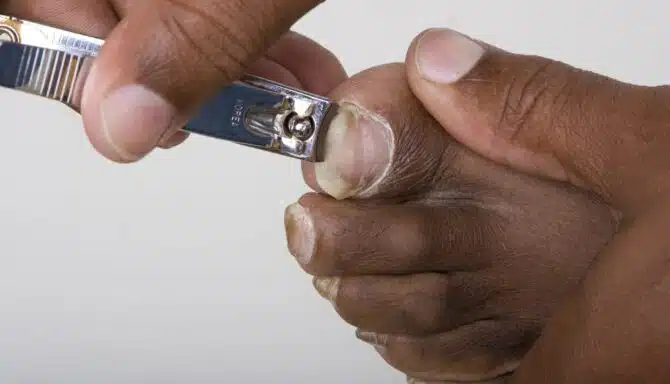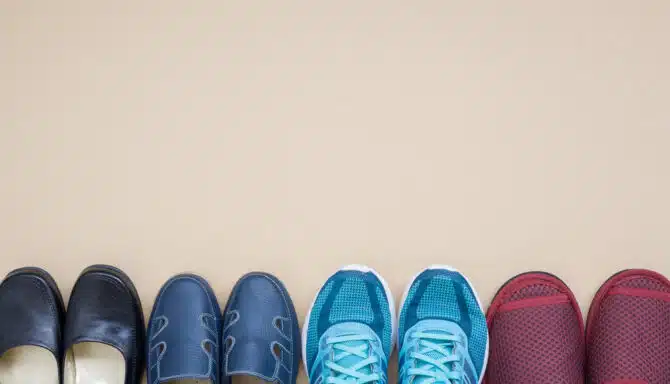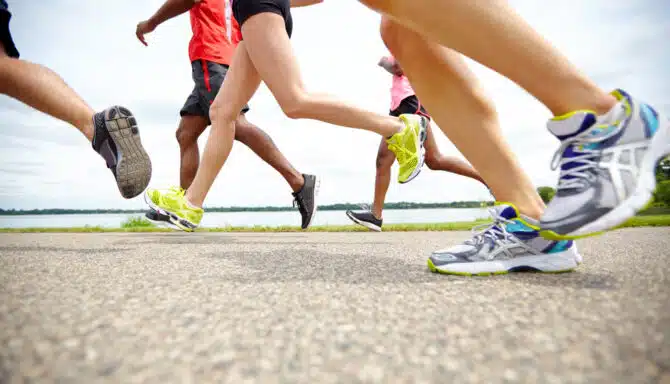July 15, 2024
Just like the rest of your body, your feet change with age. There are many age-related foot conditions that can target anyone at any time, but are more likely to occur in our golden years. With proper care, foot health in older adults doesn’t have to be too challenging and your aging feet can step out in downtown Toronto with confidence (and more importantly, in comfort).
Why Aging Feet Become Vulnerable
Studies show that one of the reasons musculoskeletal foot conditions, toe deformities and ankle problems are more common in older adults aged 65-74 is due to ill-fitting footwear.
Poorly fitted shoes not only wreak havoc on your feet, but if you’ve worn them for double the amount of years a younger adult has, then they’ve had more time to cause foot issues! The math speaks volumes and is one of the many reasons wearing good shoes from a young age is so important.
A change in size and shape also signifies your feet are getting older. Your body’s ligaments and tendons lose their ability to “spring back” which causes fallen arches (flat feet). This also relates back to ill-fitting footwear; if you aren’t aware of your foot changes, you can wear shoes that are too small without realizing it.
Your skin also becomes thinner when you get older, and your nails more brittle and fragile. Your toenails can also get thicker, but not in a healthy way. Their weakening can invite unwanted problems like fungal infections and skin conditions.
Lastly, it's only natural for a little wear and tear to set in after years of walking on your feet - after all, we only get one pair! This can cause degradation in many of the 33 joints in the foot.
Common Foot Ailments In Elderly People:
Bunions
Hammertoes
Plantar fasciitis
Osteoarthritis
Gout
Type 2 diabetes and diabetic neuropathy (commonly occurs after age 45)
Calluses
Corns
Toenail fungus
Elderly-onset rheumatoid arthritis (a different type of RA than the one that targets younger adults)
Foot Care Tips and Footwear For Seniors
Managing foot problems and caring for aging feet is achievable when you do the following:
Wear shoes that fit well! Many foot conditions feel better and more manageable when you wear orthopedic shoes, shoes for sensitive feet or the best shoes for seniors.
Also, find shoes with the right level of shock absorption to protect your joints.
Consider custom orthotics.
Perform regular, low-impact exercises and stretches to keep your feet strong and flexible. Yoga and swimming is a great idea, but there are also exercises for arthritis.
Keep your feet clean and moisturized.
Get medical pedicures to maintain your nail health.
Manage conditions like gout with proper dietary health and learn the role of nutrition in foot health.
Try other products and medical devices like bunion pads, correctors, etc.
Learn more about age-defying foot care.
July 8, 2024
Shock absorption sounds like a superpower! But it’s actually a term describing how our shoes provide impact protection from the ground, floors and pavement. This benefits our foot health, but it also begins the upward “chain of command” of protecting the joints, bones and muscles in our knees, back and legs. Shock absorption in shoes typically involves innovative footwear technology and high-quality shoe design. Let’s review everything you need to know about this fascinating topic!
The Science Behind Shock Absorption in Shoes
You may be familiar with how cars have pump-like systems called shock absorbers, which dampen impulses from driving on the pavement. Your shoes are similar, but the physics are a little different!
Shoes with a good amount of shock absorption may include the following components:
Solid shoe cushioning in the insole, often made from gel, foam, etc.
Midsoles made from comfortable and sometimes dense materials, like EVA foam. These midsoles are often able to compress and then return to their original shape during movement.
Durable outsoles, made from materials like rubber.
Extra heel cushioning for heel striking.
These features work together to protect your feet from developing musculoskeletal foot conditions, which include but aren't limited to:
Plantar fasciitis
Heel spurs
Metatarsalgia
Different types of arthritis
Achilles Tendonitis
Think about it this way: nobody wants to walk a mile in flip flops! There would be virtually nothing in between the bottom of your foot and the ground’s surface, and you would feel fatigue, pain and overall discomfort afterwards. The longer you ignore foot support and shock absorption, the more wear and tear you will sustain!
And this affects more than just your feet — your entire body feels the impact. The pain starts at the foundation, your feet, but it will trickle upward to other body parts (knees, back, etc) since your muscles, ligaments, tendons and bones are all connected to ensure our body moves efficiently and with stability.
Who Needs Shock Absorption The Most?
Athletes, especially runners, benefit from shock absorption. With each stride, they are hitting the pavement, trails and floors harder than anyone else. They need high-quality athletic footwear that retains most of its shock absorbing abilities after long-term use.
But it’s not just all-star athletes. Everyday folks enjoying an outdoor walk in downtown Toronto; the longer the walk the more shock absorption you'll need. People with disabilities like severe arthritis or those with foot conditions like bunions or hammertoes, to name a few, should also be mindful of the grounds impact on the feet and body.
A Final Note on Shock Absorption
Shock absorption can be a balancing act. Sometimes “less is more" and you want to be careful of completely eliminating the “ground feel.”
For example, overly cushioned shoes and a very elevated outsole might not be right for people with mobility challenges or those who need walking shoes instead of running shoes. Both can lead to instability and a heightened risk of sustaining a foot injury.
Athletes should also be careful. Sometimes, too soft or too thick soles can affect sensory feedback and lead to a fall.
June 18, 2024
Foot-friendly shoes and comfortable heels as wedding guest footwear? Who knew there could be such a thing! Say goodbye to the days where you have to switch shoes halfway through the wedding reception and say hello to stylish comfort shoes, pain-free heels and podiatrist-approved footwear. Today’s article will guide you towards discovering brands that make comfortable wedges and heels for when you want to attend an exciting summer wedding, but don’t want to deal with dreaded foot pain!
Brands That Make Comfortable Wedding Season Footwear
Check out some foot clinic recommendations for wedding guests, bridal parties and bridal shoes! These brands are available at Feet First Clinic - your favourite local Toronto one-stop-shop for all things foot health!
Ara
Ara combines the perfect fit with sleek style, making the ideal shoe. They have plenty of pumps, sandals, and other shoes with a short-to-moderate heel height that will help you maintain your balance and stability at the wedding, in addition to preventing nagging foot pain. They use the same comforting shoe technologies and materials as their walking shoes.
NAOT
NAOT is another ideal choice for comfortable heels and wedges. Whether you're walking down the aisle or dancing the night away, you'll find a good combination of fashion and comfort with their sandals, booties and other shoes. If you're more into fun shoe designs and prefer a short heel with minimal elevation, they might be a good choice for you.
The NAOT Pixie might be a good choice for a wedding guest who wants a very short heel that still has some elevation.
Clarks
Clarks has always been innovative in shoemaking, introducing technologies that make you feel like you’re stepping on a cloud. This also applies to their chunky wedges, heeled sandals, boots, booties, and more — all perfect for summer weddings! Emphasizing proper fit and comfort with cushioned insoles and ergonomic designs and high-quality materials such as soft leathers, Clarks ensures that every pair minimizes foot pain as much as possible.
Give our Toronto foot clinic a call for the most up-to-date shoes from Ara, NAOT and Clarks in stock! You can also stop by our Bloor West location for a shoe fitting.
A Final Note on Heels and Wedding Season in 2024
It’s tough to find the right balance between high heels and foot health. We recommend avoiding them if you have certain foot conditions like severe bunions, hammertoes, joint pain caused by arthritis, amongst others. But then again, if you like heeled shoes, there should be a way to stay true to yourself, especially for a special occasion. Look for:
Wide-toed shoes: Opt for heeled shoes with a wide and deep toe box.
Low heels: Select heels that are no higher than 2 inches to reduce strain.
Soft materials: Look for shoes made from soft, flexible materials like leather or suede that can stretch and conform to the foot shape.
Cushioned and removable Insoles: Shoes with cushioned insoles can provide extra comfort. Removing them and inserting your own custom orthotics or insoles for your foot type is also a wise move.
Remember: if your shoes exacerbate your condition, don’t wear them, even if you’ve followed these guidelines. Walking shoes and orthopedic shoes can look lovely at a wedding too! Many brides wear them to add a fun, casual spin to their wedding look.
Check out this blog on balancing elegance with foot health for even more tips on selecting the right wedding shoes this summer.
June 6, 2024
Our feet and toes change in various ways as we age. One of these changes is toenail thickening.
For some of us, toenail thickening can be more than just a minor inconvenience. It can make it difficult to cut and maintain our toenails, and can even cause pain and discomfort. In this article, we'll explain the causes of thickened toenails, and some possible treatments.
Why Do Toenails Thicken with Age?
Nails are made from a protein called keratin, which is produced at the nail plate at the base of the nail. Nail growth happens when nail cells multiply within the base of the nail and are pushed forward. However, as we age, the growth rate slows down, so the nail cells just pile up on top of each other, which causes them to get increasingly thicker.
Toenail thickening is often a result of several factors:
Reduced blood circulation
The most common cause of toenail thickening is decreased blood circulation to our feet. This diminished circulation means fewer nutrients and oxygen reach the toenails, causing them to thicken over time. Age is one of the risk factor for reduced blood circulation to the feet.
Natural wear and tear
Years of use can damage our toenails. Factors such as ill-fitting shoes, repetitive stress from activities like running or walking, and even minor trauma can contribute to thickening. Essentially, when our toenails experience trauma, they thicken to protect themselves. As we age, wear and tear on our toenails can accumulate, which can cause them to thicken.
Fungal infections
Older individuals are more prone to fungal infections of the toenails, which can cause thickening, discoloration, and brittleness. These infections often thrive in warm, moist environments like sweaty shoes or communal areas.
Underlying health conditions
Medical conditions like psoriasis, diabetes, and peripheral arterial disease can also influence toenail health. These conditions affect circulation, which in turn slows toenail growth and causes toenails to thicken.
Tips for toenail care as you age
As you age, proactive steps can be taken to maintain healthy toenails and minimize thickening. By following these tips, you can feel more in control of your foot health and well-being.
Regular trimming
Toenail thickening can make trimming and maintaining your toenails extremely difficult. Fortunately, a licensed chiropodist is trained to specifically deal with this. A licensed chiropodist can ensure your toenails are trimmed properly to prevent ingrown toenails, promote healthy toenail growth and reduce thickening. A licensed chiropodist can also use special tools over the toenail to thin it out, which will make the toenail easier to cut and maintain. Best of all, this is all done in a sterilized environment, so you don't need to worry about fungal infections (did you know 52% of people get fungal infections after visiting nail salons?) If you decide to trim your toenails at home, make sure you invest in quality toenail clippers and avoid cutting them too short.
Proper foot hygiene
Wash your feet daily with soap and water, ensuring they dry thoroughly, especially between the toes. Also, wear flip flops in public spaces to avoid contracting fungal infections.
Comfortable footwear
Choose shoes that fit well and provide adequate support. Avoid narrow or tight shoes that can put pressure the toenails and contribute to thickening.
Moisturize regularly
Apply moisturizer to your feet to keep the skin and nails hydrated. This can prevent cracking and thickening of the toenails, especially in dry climates.
Foot protection
Wear protective footwear in risky environments like communal areas or outdoors. This can help prevent injury and reduce the risk of fungal infections.
Manage underlying conditions
If you have underlying health issues like diabetes, it's important to remember that they can be effectively managed. By working closely with your healthcare provider, you can improve foot circulation and reduce the risk of complications like toenail thickening.
June 3, 2024
Do orthopedic shoes have their place in fashion? The answer is yes! While there is no doubt orthopedic shoes are designed to treat foot conditions, it doesn’t exclude them from contemporary 2024 shoe trends. Let’s review the top choices for stylish orthopedic shoes this year!
Stylish Orthopedic Footwear 2024
Orthopedic shoes usually have specific features, such as:
Built-in arch support for plantar fasciitis, etc.
Extra cushioning / shock absorption (protects your joints from the impact of the ground!)
A wide toe box for foot deformities like bunions, hammertoes, etc.
Removable insoles to give you the option of using orthotics.
A firm heel counter for proper stability or motion control.
Adjustable straps to accommodate edema (swelling) and for a snug, breathable fit.
That’s a lot to look for! And it’s a common misconception that these features look unappealing. The truth is, you can't often see these features at first glance; orthopedic shoes do not have to look clunky.
If you’re not sure where to look for comfortable and fashionable shoes, keep reading for some examples that offer the best of both worlds. The cherry on top? All of them are available at Feet First Clinic!
Anodyne No. 27
Anodyne No. 27
Anodyne shoes are designed to help treat diabetes-related foot problems and other musculoskeletal issues and deformities. The No. 27 is a simplistic white walking shoe that pairs perfectly with casual attire. Features include a rigid heel counter to help with instability, a protective toe box, a supportive sole, and more. It's a comforting staple that keeps modern fashion trends in mind!
APEX Logan Chelsea Boot
The Logan Chelsea Boot from APEX offers a good amount of depth, and a removable EVA insole to boot (no pun intended!). The side zipper and lack of laces makes it easier for people with mobility challenges to get their feet in and out. This boot is also perfect for every season, from spring all the way to winter!
APEX LOGAN CHELSEA BOOT
Aetrex Men's Milos And Women's Jess
Aetrex is a cutting edge company offering trendy orthopedic shoes. The men's Milos are an orthopaedic slide sandal that combines the comforting and supportive features you would typically find with a custom orthotic, with the breathability and stylish flair of a summer sandal. They're super durable and have great arch support and cushioning thanks to UltraSky™ EVA technology.
Like the Milos, the Jess from Aetrex is another sandal offering the same top-of-the-line arch support and cushioning. The microfibre top cover adds a layer of softness and fights against cuts, scrapes and blisters. One minor difference is the easily adjustable ankle strap for extra ankle support.
NAOT Amadora
Looking for a fashion-forward sandal with a slight platform and fun design? The NAOT Amadora is a great finishing touch for your everyday summer dresses, skirts, and more! The hook and loop strap with full upper coverage is great for those who prefer a more secure feel to their sandals. The removable, anatomic cork and latex footbed conforms to the natural shape of your foot as it moves, offering maximum comfort! The best part: the footbed is removeable so you can wear them with your custom orthotics!
Naot Amadora
May 16, 2024
Top-notch athletic foot health is key, especially when summer rolls around. Your activity level changes in the summer when you start spending more time outdoors pounding the pavement in the sun. To make sure your feet don't hold you back from your summer plans, here are our top summer sports foot care tips for healthy feet.
Preventing Summer Sports Injuries in Athletes
When it comes to foot care and sports, the right footwear and healthy exercises/stretches are always a winning combo. Below you’ll find the most common strain-related summer sports injuries and what you can do to stay on your feet!
Achilles Tendonitis
Avoid straining the Achilles tendon by gradually increasing activity intensity. For example, run shorter distances while working your way up to longer journeys.
Stretch the calf muscles / Achilles tendon every day. Try the calf exercises in this article. Also make sure you stretch your soleus muscle too!
Wear runners with an elevated heel, turned-up toe and rocker soles. (Learn more about rocker soles here.)
Ankle Sprains
Wear athletic shoes with stong ankle support while playing sports like basketball and volleyball. Shoes with wider soles can help too.
If you’re prone to sprains or tend to overpronate when you walk, try stability shoes.
Strengthen your ankles with these exercises.
Stress Fractures
Stability and motion control shoes with a more rigid design and thick soles are good for runners who may be prone to stress fractures.
Gradually increase activity intensity to avoid hurting yourself, especially if you have been on hiatus!
To avoid stress fractures while strength training or weight lifting, wear a shoe with a wider toe box, a hard/thick sole and a minimum level of cushioning.
Plantar Fasciitis
Wear the best shoes for plantar fasciitis. These tend to be stability shoes, but neutral can also work. The key thing is to look for shoes with sufficient arch support.
Perform strengthening and preventative stretches that target the plantar fascia. These include calf stretches, towel stretches, and more that you can find here.
Runner’s Knee (Patellofemoral Pain Syndrome)
Prevent knee pain by strength training, paying close attention to the quadriceps and hip muscles.
Avoid shoes with a raised heel, as they can place too much pressure on the knee joint.
There should be a medium amount of cushioning in shoes; too much can cause knee instability.
Foot Care Tips for Preventing All Injuries
Footwear should always be well-fitted and supportive, regardless of what injury you're trying to prevent.
Certain features can help defend against specific injuries, but shoes must always fit properly, leaving enough room for the foot to position itself and for the toes to spread. Shoes must also always have some level cushioning and support. Lightweight shoes tend to be beneficial for athletes when competing so they can propel forward more effortlessly. Additionally, athletes should always wear running shoes with good shock absorption; it acts as a barrier between your joints and the impact from the ground.
You can also boost your protection with custom orthotics or Superfeet insoles. These offer extra support for your feet and joints.
Preventing Skin Conditions in Athletes
One of the most infamous skin issues athletes face in the summertime are blisters. Running outside in the hot sun can cause increased friction and moisture buildup in your shoe environment. Even though most blisters go away on their own, competitive runners and racers can sometimes face serious blister complications like intense pain, sepsis, and cellulitis.
Ensure your footwear fits well so your skin isn’t rubbing harshly against your shoes. To tackle the moisture problem, try sweat-wicking socks and foot deodorants, which come as sprays, powders and creams (these can also help with foot odour and athlete's foot prevention). Medical devices like custom orthotics, insoles and blister pads can also help place feet in the best position for preventing blisters.






